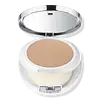Clinique Beyond Perfecting Powder Foundation + Concealer Versus Neutrogena Mineral Sheers Compact Powder Foundation
What's inside
What's inside
 Key Ingredients
Key Ingredients

 Benefits
Benefits

 Concerns
Concerns

 Ingredients Side-by-side
Ingredients Side-by-side

Talc
AbrasiveOctyldodecyl Stearoyl Stearate
EmollientZinc Stearate
Cosmetic ColorantZinc Laurate
Dimethicone
EmollientBentonite
AbsorbentHdi/Trimethylol Hexyllactone Crosspolymer
Silica
AbrasiveAstrocaryum Murumuru Seed Butter
EmollientGlycerin
HumectantSqualane
EmollientLauroyl Lysine
Skin ConditioningHydrolyzed Soy Protein
HumectantCetearyl Dimethicone Crosspolymer
Lecithin
EmollientTocopheryl Acetate
AntioxidantTetrahexyldecyl Ascorbate
AntioxidantWater
Skin ConditioningMagnesium Myristate
Potassium Sorbate
PreservativeCoconut Acid
CleansingTetrasodium EDTA
Chlorphenesin
AntimicrobialMica
Cosmetic ColorantCI 77891
Cosmetic ColorantCI 77491
Cosmetic ColorantCI 77492
Cosmetic ColorantCI 77499
Cosmetic ColorantCI 77007
Cosmetic ColorantCI 77163
Cosmetic ColorantCI 15850
Cosmetic ColorantCI 42090
Cosmetic ColorantCI 75470
Cosmetic ColorantTalc, Octyldodecyl Stearoyl Stearate, Zinc Stearate, Zinc Laurate, Dimethicone, Bentonite, Hdi/Trimethylol Hexyllactone Crosspolymer, Silica, Astrocaryum Murumuru Seed Butter, Glycerin, Squalane, Lauroyl Lysine, Hydrolyzed Soy Protein, Cetearyl Dimethicone Crosspolymer, Lecithin, Tocopheryl Acetate, Tetrahexyldecyl Ascorbate, Water, Magnesium Myristate, Potassium Sorbate, Coconut Acid, Tetrasodium EDTA, Chlorphenesin, Mica, CI 77891, CI 77491, CI 77492, CI 77499, CI 77007, CI 77163, CI 15850, CI 42090, CI 75470
Mica
Cosmetic ColorantTitanium Dioxide
Cosmetic ColorantOctyldodecyl Stearoyl Stearate
EmollientSilica
AbrasiveZinc Stearate
Cosmetic ColorantDimethicone
EmollientMagnesium Myristate
Oryza Sativa Starch
AbsorbentMethicone
EmollientPolymethyl Methacrylate
Methylparaben
PreservativeSodium Dehydroacetate
PreservativeAlumina
AbrasiveNylon-12
Panthenol
Skin ConditioningPropylparaben
PreservativeGlycine Soja Seed Extract
Skin ConditioningTocopheryl Acetate
AntioxidantAscorbic Acid
AntioxidantPantothenic Acid
Skin ConditioningRetinyl Palmitate
Skin ConditioningIron Oxides
CI 75470
Cosmetic ColorantMica, Titanium Dioxide, Octyldodecyl Stearoyl Stearate, Silica, Zinc Stearate, Dimethicone, Magnesium Myristate, Oryza Sativa Starch, Methicone, Polymethyl Methacrylate, Methylparaben, Sodium Dehydroacetate, Alumina, Nylon-12, Panthenol, Propylparaben, Glycine Soja Seed Extract, Tocopheryl Acetate, Ascorbic Acid, Pantothenic Acid, Retinyl Palmitate, Iron Oxides, CI 75470
Ingredients Explained
These ingredients are found in both products.
Ingredients higher up in an ingredient list are typically present in a larger amount.
Ci 75470 is a bright-red pigment. It is AKA carmine.
Carmine is derived from insects such as the cochineal beetle. This ingredient has been used as a natural dye for over 2000 years.
Dimethicone is a type of synthetic silicone created from natural materials such as quartz.
What it does:
Dimethicone comes in different viscosities:
Depending on the viscosity, dimethicone has different properties.
Ingredients lists don't always show which type is used, so we recommend reaching out to the brand if you have questions about the viscosity.
This ingredient is unlikely to cause irritation because it does not get absorbed into skin. However, people with silicone allergies should be careful about using this ingredient.
Note: Dimethicone may contribute to pilling. This is because it is not oil or water soluble, so pilling may occur when layered with products. When mixed with heavy oils in a formula, the outcome is also quite greasy.
Learn more about DimethiconeWe don't have a description for Magnesium Myristate yet.
Mica is a naturally occurring mineral used to add shimmer and color in cosmetics. It can also help improve the texture of a product or give it an opaque, white/silver color.
Serecite is the name for very fine but ragged grains of mica.
This ingredient is often coated with metal oxides like titanium dioxide. Trace amounts of heavy metals may be found in mica, but these metals are not harmful in our personal products.
Mica has been used since prehistoric times throughout the world. Ancient Egyptian, Indian, Greek, Roman, Aztec, and Chinese civilizations have used mica.
Learn more about MicaOctyldodecyl Stearoyl Stearate is created from stearic acid.
It is an emollient and thickens the lipid (oil) portion of a product. Due to its emollient properties, it may not be fungal-acne safe.
Silica, also known as silicon dioxide, is a naturally occurring mineral. It is used as a fine, spherical, and porous powder in cosmetics.
Though it has exfoliant properties, the function of silica varies depending on the product.
The unique structure of silica enhances the spreadability and adds smoothness, making it a great texture enhancer.
It is also used as an active carrier, emulsifier, and mattifier due to its ability to absorb excess oil.
In some products, tiny microneedles called spicules are made from silica or hydrolyzed sponge. When you rub them in, they lightly polish away dead skin layers and enhance the penetration of active ingredients.
Learn more about SilicaTocopheryl Acetate is AKA Vitamin E. It is an antioxidant and protects your skin from free radicals. Free radicals damage the skin by breaking down collagen.
One study found using Tocopheryl Acetate with Vitamin C decreased the number of sunburned cells.
Tocopheryl Acetate is commonly found in both skincare and dietary supplements.
Learn more about Tocopheryl AcetateZinc Stearate is the metal salt of stearic acid. It is a white solid used to bind, thicken, and lubricate products.
This ingredient is common in powder makeup, where it helps keep the powder together.
Zinc Stearate is hydrophobic and repels water.
This ingredient can be sourced from non-animal or animal sources. It is best to reach out to the brand to see where they source this ingredient from.
Learn more about Zinc Stearate